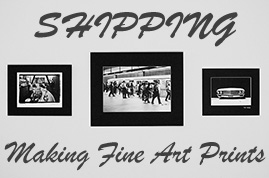Making Fine Art Prints: Shipping
I think we're finally winding down on this series of articles — maybe just one more to pull it all together at the end. This article will dive into some of the discussion about packaging and shipping your fine art prints. With each step in the process of print making, the piece becomes a little more complete. At the end, you might have to send it to a new owner, and all that hard work is out of your hands during the transit.
So I'd like to discuss the various methods for packaging prints depending on their final state: print only, large prints, small prints, mounted prints, and framed prints. On all of these points, I'd like to hear from those who have packaged and shipped prints of their own. There are a lot of little ins-and-outs when it comes to this topic, so I'm sure we could all learn something from each other.
PRINT ONLY: SMALL
Packaging and shipping prints without the mount, mat, or frame is generally the most cost effective. If you go this route (also assuming that the recipient is ok with the idea) there are a few options for packaging the print. Smaller prints, such as 8×10 or 11×14 (or smaller), will fit into things like photo mailers. These are reinforced envelopes that resist bending and folding. They're inexpensive (on the order of $1/envelope) and you can find them at most office supply stores or other stores online.
The downside to these envelopes is that they can be damaged rather easy depending on their construction. I had a few prints go out only to arrive all chewed up and bent because of poor handling at the post office. The lesson here: use a photo mailer that's large enough to house the print sandwiched between two pieces of cardboard. The extra material will help protect the print.
For small prints, you can also use things like shipping tubes or boxes, but it's often not necessary if you take the extra steps to protect the print.
PRINT ONLY: LARGE
Any print over 11×14 will be more prone to damage if packaged in a photo mailer or envelope. In this case, shipping tubes provide a good means of protection at a fairly low cost. Yup, prints can be rolled up without damage — they'll just have to be flattened upon arrival. If shipping via tube, I'd suggest getting a 3-inch diameter tube with the thickest wall you can find. Tubes will get crushed pretty easily, and it doesn't take much to damage a print that's rolled up inside.
I actually had a tube (and print) get damaged in the mail recently. So my professional printer, Oscar Medina, suggested a packaging technique to me: roll the print between 1/2-inch to 1-inch smaller in diameter than the tube, then use packing paper to “float” the print in the center of the tube. This method allows for the tube to encounter some amount of damage without harming the print inside. And if you really want to be careful, double-tube the print with something like a 2-inch tube floating inside of a 3-inch tube.
FRAMED PRINT
Whether the print is only mounted or completely framed, you now have a rigid piece to work with. Smaller prints can be packaged inside cardboard boxes with lots of packing material to keep it away from the edges. But larger prints will require heavier box material, foam liners, and other safeguards. Just doing a quick search, I found a company that produces boxes and sleeves for fine art shipping: Airfloat Systems. I haven't tried their products, but it looks promising.
I actually haven't packaged and shipped any framed work, so I'm going to have to lean on you guys for this part of the discussion. Anybody out there have some tips for what to use and what not to use? At any rate, I know that larger framed prints can cost several hundreds of dollars to package and ship — so be aware of this extra expense if you plan on doing this.
SHIPPING
Once you have your print all packaged-up and safe, it's time to get it in the mail! I won't get into the differences between the USPS, FedEx, UPS, etc — they all ship stuff. I find that the USPS tends to be the inexpensive option, even for international shipping. But I also find that they're pretty rough with the merchandise.
So no matter what shipping service you decide to use, there are a few things you should be doing with your prints. First of all, insure them! The cost isn't usually outrageous, and it's an easy way to help recover the cost of a damaged print. Sure, the claims process is painful and your print will never be damaged if you pay for the insurance (half joking here, but it always seems to be the case). But it's good for peace of mind. Insure the package for at least the cost of the materials — that way the damaged print won't be coming out of your pocket.
Another thing to do is cover the package in stickers and stamps that say things like “Fragile”, “Photo Inside”, “Do Not Bend”, etc. This isn't a safeguard, but it might help catch the attention of a careless mail handler and make them think twice about what they're doing.
WHAT ELSE?
Do you guys have any further tips and suggestions for packaging and/or shipping prints? Like I said, there are a lot of little tricks to this stuff and I'm sure I don't know all of them. What have you had success with? And what has failed? Any horror stories on this topic?
FOLLOW THIS SERIES OF ARTICLES!
BACK — FRAMING


Sean Galbraith
July 16, 2009I don’t have any tips beyond what you have inlcuded here. Myself, I don’t ship anything framed. Too fragile. If you are shipping framed pieces, consider using plexiglass instead of glass.
Brandon T.
July 16, 2009Great tips, perfect timing now that I’m selling prints and was curious on the best way to ship. Thanks
Justin Korn
July 16, 2009Great finish to this series Brian! Thanks for the tips, now I need to put them all to work 🙂
LouH
July 18, 2009I’ve been struggling my way round this recently, as will anyone who recognises the possibilities to sell online. For the moment I’m skirting round the issue of selling and posting framed prints – the cost of securely packing and shipping outweighs the cost of my modestly priced prints.
I prefer to keep prints flat, not rolled, because I think the customer will get a better first impression when they open their package. They don’t have to flatten it, and it immediately looks good. Plus, I offer mounted but unframed prints, so any post method will need to cope with big flat stuff. The print (in a plastic sleeve) is sandwiched between two correx boards and put in a snugly fitting heavy duty envelope. Correx is white twin wall rigid plastic board – light, clean, stiff. Easy to buy in small amounts as estate agents love it for their signs. Twin-wall cardboard would be as rigid, but is heavier and harder to buy in small amounts. (tip for either cardboard or correx – have the corrugations run lengthways on one piece and widthways on the other. Works like plywood to make it even stiffer.)
The interesting part is looking at post prices at different sizes for UK, Europe and further afield. Those of you in the USA will have a very different perspective. Basically, I found that shipping mounted prints outside the UK would be troublesome and pricey, so I’m chickening out again and offering only unmounted prints for Europe and Rest of World under my standard pricing model. I even have to resort to tubes rather than flatpack for the 16×20 print. It goes without saying that if someone really wants a mounted/framed print to be shipped to anywhere in the world I’ll be happy to do it at an individually priced shipping charge.
One thing that you haven’t mentioned, Brian, is post charges. You need to cover the cost of posting, packing and time. Do you charge this above the cost of the print? Some people absorb all into the print price, so that post is free within the UK, for example. I thought long and hard about what my target audience would find more acceptable – cheaper print with big extra cost, or all-in-one charge. I took the middle ground. By absorbing some post charge into the print price, I could create a pricing model that was essentially very simple. For my target customer, that’s important. I’d love to know how others approach this.
Kristina
December 9, 2009THANKS! I was really worried about shipping my first piece. These comments have been very helpful and I really appreciate all the various input.
thanks again!
hk
December 11, 2009shipping large prints flat is a BAD idea, especially if you are using USPS.
I thought the same, it looked better, made a better impression, etc, but after numerous angry customers realized it’s NOT the way to go. I packed them up too, cardboard on both sides 1″ bigger than the print all around, then in a padded envelope, people still got butchered prints.
Since going to tubes I have received NO complaints, end of story as far as I’m concerned.
Jen
April 23, 2010Hi all!
thanks for all the info and the posts! I am consigning a stack of prints on ebay for a local gallery here and lost one print to trying to ship it flat… so went stickly to tubes for larger prints. Now I have an angry “art dealer” customer because I rolled it!! He claims it crinkled on the sides from being rolled. (not from anything the post office did to it) he’s completely blaming me.
I know from dealing with the public for many years now that you can never have 100% happy customers, it just isn’t possible, but I am glad to read here that I am doing things the best way I can.
I love the idea of “floating” the print inside the tube. Will have to start that!
Thanks again all!
jen